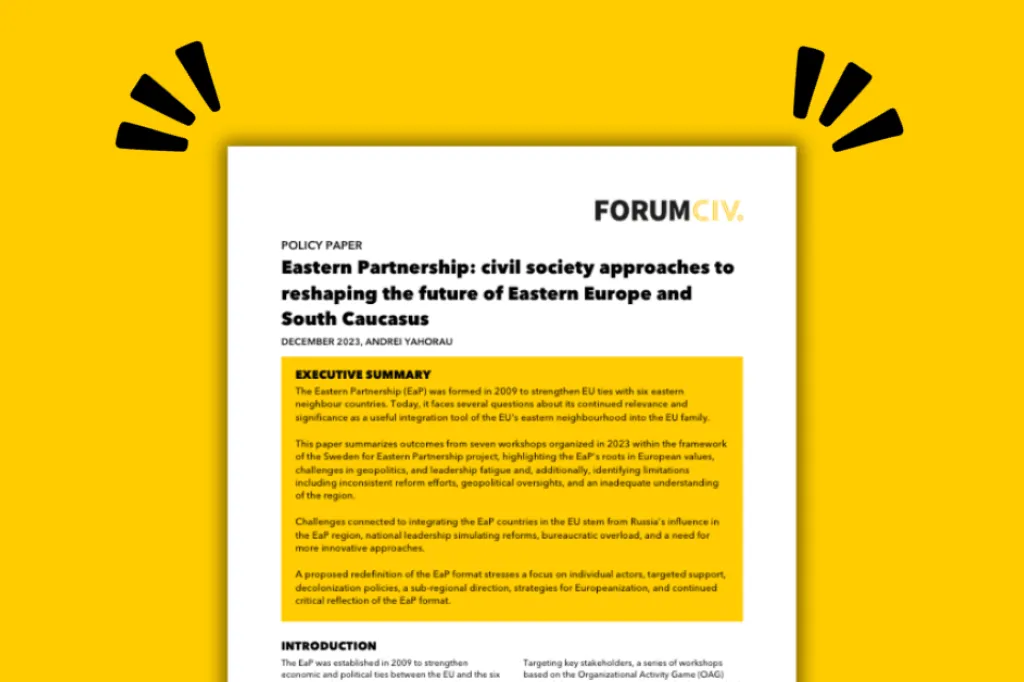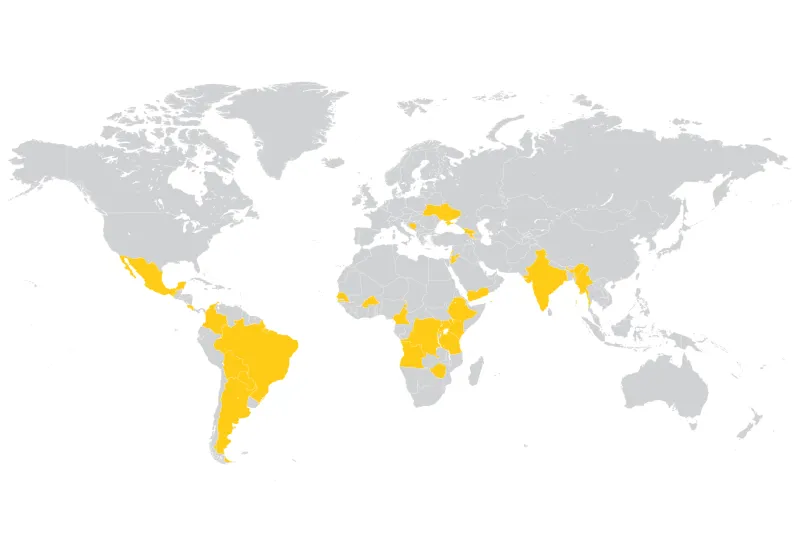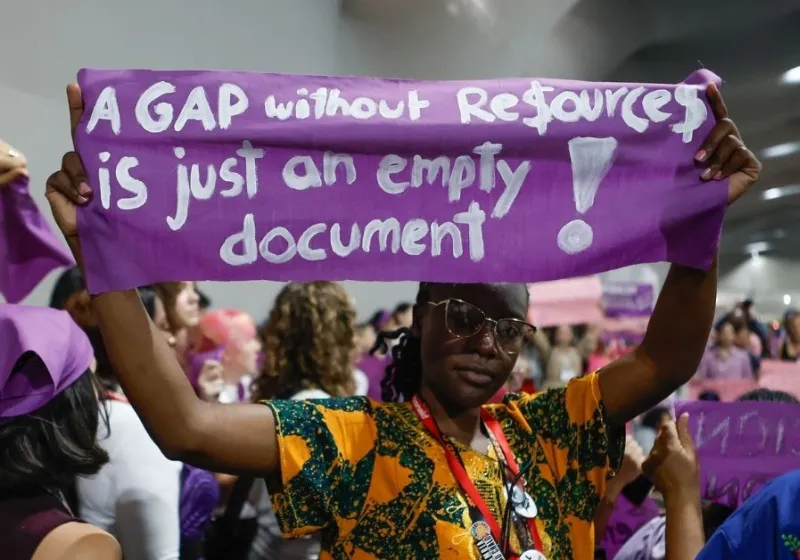Eastern Partnership: civil society approaches to reshaping the future of Eastern Europe and South Caucasus

Executive Summary
The Eastern Partnership (EaP) was formed in 2009 to strengthen EU ties with six eastern neighbour countries. Today, it faces several questions about its continued relevance and significance as a useful integration tool of the EU's eastern neighbourhood into the EU family.
This paper summarizes outcomes from seven workshops organized in 2023 within the framework of the Sweden for Eastern Partnership project, highlighting the EaP's roots in European values, challenges in geopolitics, and leadership fatigue and, additionally, identifying limitations including inconsistent reform efforts, geopolitical oversights, and an inadequate understanding of the region.
Challenges connected to integrating the EaP countries in the EU stem from Russia's influence in the EaP region, national leadership simulating reforms, bureaucratic overload, and a need for more innovative approaches.
A proposed redefinition of the EaP format stresses a focus on individual actors, targeted support, decolonization policies, a sub-regional direction, strategies for Europeanization, and continued critical reflection of the EaP format.
Introduction
The EaP was established in 2009 to strengthen economic and political ties between the EU and the six eastern neighbour countries: Armenia, Azerbaijan, Belarus, Georgia, Moldova, and Ukraine. Following Russia's full-scale invasion of Ukraine in February 2022, a considerable debate regarding the continued relevance and significance of the EaP rose among EU member states and the EaP countries. Ongoing discussions have centred on reevaluating the future trajectory of the partnership.
Sweden, having played a pivotal role as one of the architects of this framework, has remained a strong advocate for the framework. During the Swedish EU Council Presidency between 1st January – 31st June 2023, ForumCiv, supported by the Swedish Ministry for Foreign Affairs, launched the Sweden for Eastern Partnership initiative to transcend bureaucratic discourses within the EU, focusing instead on pushing for discussions towards pragmatic reforms for the EaP, amidst pressing challenges and prospects.
Targeting key stakeholders, a series of workshops based on the Organizational Activity Game (OAG) methodology were organized within the framework of the project. This approach aimed to stimulate authentic and thorough dialogues regarding the essence and objectives of the EaP for each participating country and the broader region.
This policy paper synthesizes the outcomes derived from seven workshops conducted in 2023. Leveraging the OAG methodology, these workshops facilitated a comprehensive integration of civil society perspectives, thereby contributing valuable insights into shaping new policy priorities for the EaP.
Background
The EaP initiative gains its significance and objective from a broader historical context. It revolves around the overarching concept of Europe and Europeanization, signifying the process of evolving nto Europe while reevaluating what Europe is and its essence. While the historical scope of Europe has continuously developed, presently, it embodies a realm that champions values like human dignity, fundamental freedoms, democracy, the rule of law, and human rights.
The idea of Europe is not static, and there exists a notion of what lies beyond its confines, often categorized by additional descriptors like Central Europe, Eastern Europe, or the European neighbourhood. The EaP, encompassing six of the EU's eastern neighbours, represents a distinctive space in the process of becoming Europe but has yet to achieve that status fully.
The EaP, encompassing six of the EU's eastern neighbours, represents a distinctive space in the process of becoming Europe but has yet to achieve that status fully.
Beyond the focus on European values, the EaP's significance is shaped within the framework of European integration. While Europeanization pertains to the adoption of European norms and standards, European integration primarily focuses on expanding the sphere covered by the political and economic institutions of the EU. This integration extends beyond current EU territories, encompassing countries aspiring for EU membership or transforming their institutions along EU lines.
The EaP was created to help six of the EU's eastern neighbours, which were not previously covered by the enlargement policy, complete their transformation into modern European nation-states. Although the EaP did not involve integrating partner countries into the EU, it sought to provide all tools for organizing reforms along the European model and maximizing rapprochement with the EU.
Though the EU did not aim to integrate the EaP countries, the mere inclination of these nations toward the EU and Europeanization caused significant geopolitical tensions in the region. Russia, driven by a neo-imperialist policy, was disinclined to bolster the independence of the region's countries. It realized that separating these nations from the sphere of Russian influence would effectively dismantle its imperial ambitions. While the geopolitical essence of the EaP was fundamental to its inception, this aspect needed to be more adequately considered by the EU.
An oversight that diminished the transformational potential of the EAP and resulted in a less severe acknowledgement of the threat posed by Russia. Equally problematic was the inconsistent approach of the EaP countries in pursuing Europeanization, coupled with the EU's lukewarm desire to integrate these nations into its realm. These countries demonstrated inconsistency in their reform efforts, often merely simulating progress, while with little eagerness to embrace new EU membership candidates, the EU allowed such an approach.
The inconsistent reform approaches of EaP countries and the EU's tepid inclination toward new membership candidates have contributed to a problematic trajectory. Since 2009, these countries have undergone significant upheavals, democratic revolutions, conflicts, and divergent paths toward European integration. Belarus's authoritarian regime withdrew from the Partnership in 2020, while Russia's aggression against Ukraine in 2022 heightened regional contradictions and propelled certain countries toward deeper EU integration.
Methodology
Organizational Activity Games (OAGs) are designed to foster collective problem-solving. Unlike conventional conference settings where a select few experts dominate discussions, OAGs facilitate inclusive dialogues among all participants. These sessions are structured around adaptable scenarios, prioritizing dynamic exchanges over predefined solutions to specific problems.
Under the framework of Sweden for Eastern Partnership, a team of specialized game engineers led by Andrei Yahorau and Vira Danilova was engaged to orchestrate and guide a total of seven workshops. During spring 2023, preparatory workshops occurred across the six EaP countries. These preliminary sessions aimed to pinpoint domestic concerns, align them with EU and EaP policies, and determine the participants' composition for the culminating workshop in Stockholm, which brought together participants from all six EaP countries and experts from the EU to discuss regional challenges and solutions.
The comprehensive nature of the EaP, encompassing political, economic, environmental, cultural, gender, educational, and scientific dimensions, presented a formidable challenge in accurately reflecting all pertinent viewpoints within the game dynamics. The assembly of participants leaned notably towards civil society representatives and experts from both EaP and EU nations. This composition deliberately included politicians, parliamentarians, donors, implementers, and officials from EU institutions and member states. Consequently, discussions often gravitated towards the perspectives of civil society actors and expert insights, shaping the discourse.
Results
The following chapter recounts the results of an OAG outside of Stockholm between June 26-28th 2023. Seventy-five representatives from the six EaP countries and a few EU member states participated in the game. The results of these discussions are thematically organized and presented here.
Sandwich scheme
Since the beginning, the EaP has focused on providing tools for transformation based on the European model (such as financial assistance, infrastructural programs, and inter-institutional cooperation). By making aid conditional on reform progress and implementation of signed agreements, the EU is responsible for pushing national governments to implement necessary reforms and to transform their legislation and institutions along European standards. Simultaneously, public actors and civil society, often supported by the EU, have pressured national governments to adopt European values.
This has resulted in what was deemed a “sandwich scheme” by the workshop participants, which has had several consequences:
- Successful outcomes of this scheme were observed in countries with more democratic governance and robust civil society, while authoritarian nations like Belarus and Azerbaijan did not respond positively.
- Though the primary beneficiary of the EaP, national governments have not developed more enthusiasm for adopting European values, which has led to a superficial enactment of reform processes.
- The modest aspirations of national governments and the EU have resulted in a routine and bureaucratic initiative, evident in EU-government relations and EU-civil society engagement.
- As a result of the predominant focus on ties between the EU and national governments, there needs to be more development of regional and multilateral relations between countries.
- A noticeable divergence has emerged among the EaP countries, no longer bound by a unified framework of relations, accentuating disparities among them.
Geopolitical aspects of the EaP
The geopolitical implications of the EaP have always been ignored at the level of policy development, political declarations, and political statements. Until 2022, the region was locked in a grey zone of competitive relations between Russia and the EU. As a result, efforts have yet to be made to implement structures specifically aimed at strengthening the EaP countries to counter and resist confrontation with Russia in the security, information, humanitarian, and cultural spheres.
Today, the geopolitical situation is determined by each country’s relationship with Russia and other powerful nations, like Türkiye, Iran and China. These three nations influence relations between countries in the region, the dynamics of different conflicts and the relationship between the EaP countries and the EU. Yet, this factor has not and is still not fully considered within the EaP framework.
Paper Region
The EaP comprises six eastern neighbours to the EU that share a common colonial history of being part of the Russian Empire and the Soviet Union, and the legacy of that heritage, which in today’s geopolitical landscape entails the threat of once again being absorbed by Russia. For the past decade, we have witnessed an asymmetrical approach to European integration and Europeanization by the EaP states, with some making progress and others simulating reforms or completely withdrawing from the initiative.
For the past decade, we have witnessed an asymmetrical approach to European integration and Europeanization by the EaP states, with some making progress and others simulating reforms or completely withdrawing from the initiative.
The fact that there are sub-regions (Belarus-Ukraine, Ukraine-Moldova, Armenia-Georgia-Azerbaijan) within the EaP that are more culturally and historically connected should be taken into consideration in discussions about the future of the EaP.
The geopolitical aspects and the regional nature of the EaP have yet to be better understood and thus need to be adequately considered in decision-making. A lack of understanding of the region has resulted in a discrepancy between the political goals of the EaP framework and the reality on the ground. Because the EaP countries do not necessarily view themselves as belonging together, regionality has always been down-prioritized to what is beneficial for national government vis a vis the EU.
Lately, the responsibility for the regional dimension of the EAP has been fully transferred by the national governments to the EU, which is beneficial since it allows the maintenance of a single policy about six countries at once.
This approach is generally convenient for the EU since:
- Involving all 27 EU member states, including those less invested in the EaP region, ensures a comprehensive approach to the framework.
- A regional approach reduces expenses by addressing issues across multiple countries simultaneously.
- Leading countries like Ukraine, Moldova, and Georgia can serve as models for others' aspirations.
- The EU's involvement in the region is valuable, and collaborative efforts involving all stakeholders are essential for effective regional policies.
State vs individual actors
The EaP countries tend to be viewed as uniform entities represented by their national governments. However, the political landscape in these nations is diverse, featuring varied elites, a diverse civil society, and emerging non-traditional civil society groups that sometimes rely on spontaneous forms of organization. These unconventional groups could serve as potent agents for Europeanization. Yet, a challenge lies in traditional political entities finding ways to engage with such actors effectively.
Interestingly, the drive towards European values within EaP countries primarily stems from civil society and new non-traditional civil society groups.
Interestingly, the drive towards European values within EaP countries primarily stems from civil society and new non-traditional civil society groups. Due to the EU's lack of ambitious goals and transparent criteria for Europeanization within the EaP, actions and decisions are often perceived by civil society and Euro-enthusiasts in the region as inconsistent, straying from values, and playing into the hands of local elites in superficially simulating Europeanization.
Many intra-political actors, including citizens, NGOs, media, business, political parties, academia, and various interest groups, significantly influence the Europeanization process. However, these diverse groups are inadequately considered in EaP programs, undermining their effectiveness. Nonetheless, within these groups lie actors keen on expanding European values and fostering the European space in their countries.
Unstable democratization
Challenges in European transformation and democratization within the EaP region are notably shaped by Russia's influence and the prevalence of autocratic regimes. Authoritarianism not only obstructs Europeanization efforts within countries like Belarus and Azerbaijan but also casts a deterrent effect on neighbouring nations. In a way, the conflict between Armenia and Azerbaijan impedes Armenia's path towards Europe.
The journey towards democracy and European integration inherently involves uncertainty and instability, contradicting the EU's preference for a stable neighbourhood. Stability often follows a phase of transformative unrest, as seen in Ukraine. All regions' countries encounter turbulence while establishing democratic institutions and distancing themselves from Russia. However, the discussion often sidesteps the uncomfortable topic of the cost of democratization and Europeanization. Consequently, these critical issues are disregarded, hindering substantive discourse and problem-solving.
Leadership
In its early days, the EaP involved prominent EU leaders and vibrant civil society figures, sparking debates about its essence, direction, and structure. Over the last decade, the EaP has established numerous institutions, infrastructure, and bureaucratic mechanisms, both bilaterally and multilaterally. However, this growth has led to a noticeable decline in dynamism.
Present discussions within the EaP reflect fatigue, repetitive approaches, and an overload of bureaucratic jargon. There's an excessive focus on Euro-centric terms like resilience, security, and stability, emphasizing a consumer-like view of the EU. This has shifted responsibility for EaP decisions solely to the EU, hindering critical reflection.
The departure of influential political leaders and active civil society members has left the EaP in the hands of European bureaucrats, creating a void in setting new goals and offering fresh perspectives. While active, the infrastructure of civil society is entrenched in routine activities, needing more capacity to generate innovative ideas.
The current EaP structure lacks intrinsic mechanisms for critical self-reflection and the creation of unconventional solutions for its advancement. While the EaP has bolstered European integration infrastructure, it has drifted away from the essence of European values, thereby losing sight of the true significance behind its institutional framework.
Conclusions
The new EaP framework's future significance lies in three key aspects:
Reshaping EU member-state integration: The initiative's value hinges on redefining Europeanization beyond mere institution-building. Focusing solely on mimicking European structures dilutes its essence, causing disinterest among genuine Europeanization advocates.
Geopolitical liberation: By framing the EaP as a tool for Europeanization, six of the EU's eastern neighbours are liberated from their historical reliance on Russia, marking a shift in geopolitical dynamics.
Shifting focus from states to actors: Progress in Europeanization cannot solely be attributed to a country's overall stance but is driven by specific actors within the EaP nations. For example, Ukraine's advancement towards EU membership isn't merely due to its government's pro-European stance but rather the presence and strength of various pro-European actors within its borders.
Based on the result of the workshop conducted within the Sweden for Eastern Partnerships project presented in this paper, recommendations for redefining and reformulating the EaP framework are as follows:
Shifting focus from states to individual actors: The EaP formate should provide tools for Europeanization driven by individual actors within the EaP region and EU countries.
Targeting support for pro-EU actors: Individual actors within the EaP region (civil society, state institutions, industries and local authorities) who embrace and push for European values should be applicable to receive targeted support.
Pushing for decolonization of the region: The EaP must openly adopt anti-imperialist and decolonization policies. Prioritize hard and soft security as a fundamental aspect of the framework. Shift from defensive measures against Russian disinformation to proactive promotion of pro-European narratives.
Favouring sub-regional over regional initiatives: Move away from large-scale region-wide projects due to diverse country dynamics. Embrace sub-regional endeavours and bilateral or trilateral cooperation among Eastern Partnership countries and actors (such as forums, academic networks, cultural and media collaborations).
Fostering long-term bilateral strategies: Develop sustainable strategies for partner countries and push for Europeanization.
Acting promptly and decisively: Display greater ambition and resolve in offering European perspectives and declaring candidate statuses. Delays in these matters disappoint pro-European actors within the EU.
Encouraging reflection and critical thinking: Enhance opportunities within the framework for critical discussions on the EaP, regularly facilitating gatherings that bring together a diverse set of actors for critical reflections about how to move forward.
Other recent articles

ForumCiv enters new strategic partnership
ForumCiv is proud to announce a new three-year strategic partnership with Sida, totalling SEK 137 million.

ForumCiv at COP30: African voices at the centre of climate justice
ForumCiv is participating in COP30 in Belém to amplify the voices of African civil society, who stand at the frontlines of the climate crisis yet are often excluded from decision-making.

Building peace through equality: seven actions to end violence against women
The webinar Violence Against Women in the Context of Peace, Security, and Conflict brought together speakers and participants from Armenia, Belarus, Georgia, Sweden, and international organizations to...